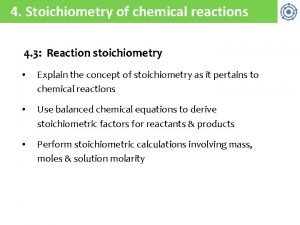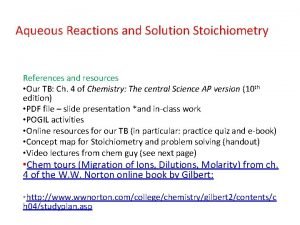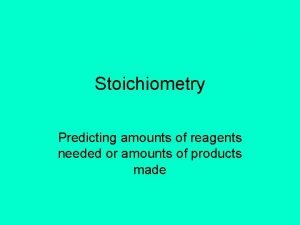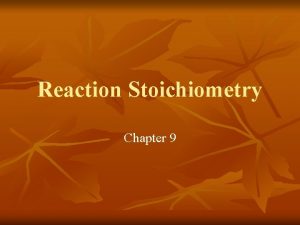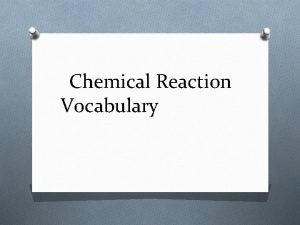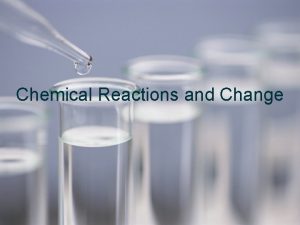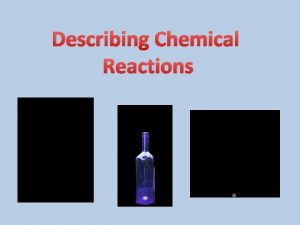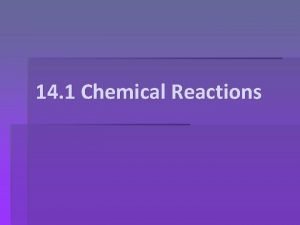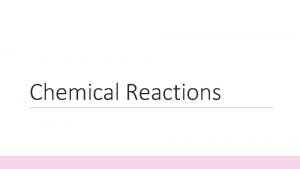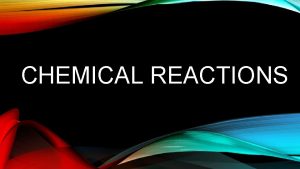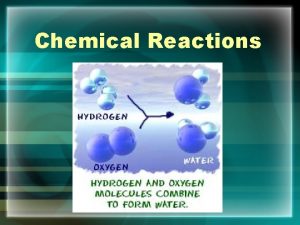4 Stoichiometry of chemical reactions 4 3 Reaction













- Slides: 13

4. Stoichiometry of chemical reactions 4. 3: Reaction stoichiometry • Explain the concept of stoichiometry as it pertains to chemical reactions • Use balanced chemical equations to derive stoichiometric factors for reactants & products • Perform stoichiometric calculations involving mass, moles & solution molarity

What is stoichiometry? Stoichiometry: the chemistry term for the ratio relationships between reactants & products • From the Greek: ‘stoicheion’ (element) and ‘metron’ (measure) 2 graham crackers + 2 chocolate bars + 1 marshmallow 1 s’more Camping with 6 friends and want 2 s’mores each? • Need to make a dozen s’mores. What do you need to bring? • Use the balanced chemical equation to make stoichiometric conversion factors. 12 s’mores 2 graham crackers = 24 graham crackers 1 s’more 12 s’mores 2 chocolate bars = 24 chocolate bars 1 s’more 12 s’mores 1 marshmallow = 12 marshmallows 1 s’more

The stoichiometry of chemical equations The Haber-Bosch reaction is used to make ammonia from hydrogen & nitrogen gas: sis e h nt y s on N 2(g) + 3 H 2(g) 2 NH 3(g) acti re Use the balanced chemical equation to make all possible stoichiometric conversion factors. 1 mole N 2 3 moles H 2 1 mole N 2 2 moles NH 3 3 mole H 2 2 moles NH 3 How many moles of each diatomic gas would be needed to make 100 moles of ammonia? 17 1 oo moles NH 3 1 mole N 2 = 50 moles N 2 2 moles NH 3 1 oo moles NH 3 3 mole H 2 = 150 moles H 2 2 moles NH 3

So, try this How many moles of I 2 are required to react with 0. 429 mole of Al? 2 Al(s) + 3 I 2(s) 2 Al. I 3(s) 18 0. 429 mol Al 3 mol I 2 = 0. 644 mol I 2 2 mol Al mol I 2 esis h t syn tion reac Al (s) + I 2(s) Chemistry Openstax Heat caused by the reaction turns some I 2 into purple I 2 gas.

Mole map for chemical reactions? A mole map can help make use of this new stoichiometric conversion factor. (1) To relate the amount of reactant (A) to product (B). (2) To relate the amount of two reactants (A & B) or products to one another. 1 2 A 5 B 2 mass (g) A MW A (g/mol) 2 A + 3 B 4 C + 5 D moles A mass (g) B moles B Stoichiometric ratio of A: B MW B (g/mol)

Using this mass-mole map What mass of sodium hydroxide is required to produce 16 g of milk of magnesia, Mg(OH)2? Mg. Cl 2(aq) + 2 Na(OH)(aq) Mg(OH)2(s) + 2 Na. Cl(aq) Strategy: mass P moles R mass R MW P R: P ratio MW R Mg(OH)2 = 58. 30 g/mol Na(OH) = 40. 00 g/mol 16 g Mg(OH)2 1 mol Mg(OH)2 58. 30 g 2 mol Na(OH) 1 mol Mg(OH)2 19 ge n a h exc le dis) ub (do ction rea 40. 00 g Na(OH) 1 mol Na(OH) = 22 g Na(OH)

Try this What mass of oxygen gas is consumed when 702 g of octane are combusted? 20 2 C 8 H 18 + 25 o 2 16 CO 2 + 18 NH 2 O Strategy: octane (g) octane (mol) O 2 (g) MW octane O 2: octane ratio MW O 2 on i t s bu n m co tio c a re C 8 H 18 = 114. 23 g/mol O 2 = 31. 98 g/mol 702 g C 8 H 18 1 mol C 8 H 18 114. 23 g 25 mol O 2 2 mol C 8 H 18 31. 98 g O 2 = 2. 46 E 3 g O 2 1 mol O 2

Relating molecules to moles A mole map can help make use of this new stoichiometric conversion factor to numbers of molecules rather than mass. (1) To relate the amount of reactant (A) to product (B). (2) To relate the amount of two reactants (A & B) or products to one another. 1 2 A 5 B 2 molecules A Avogadro’s # 2 A + 3 B 4 C + 5 D moles A moles B Stoichiometric ratio of A: B molecules B Avogadro’s #

Using the molecule-mole map How many carbon dioxide molecules are produced when 0. 75 mol of propane (C 3 H 8) are combusted? 21 C 3 H 8 + 5 O 2 3 CO 2 + 4 H 2 O Strategy: moles C 3 H 8 moles CO 2 molecules CO 2: C 3 H 8 ratio 0. 75 mol C 3 H 8 3 mol CO 2 1 mol C 3 H 8 Av’s # on i t s bu n m o c tio c a re 6. 02 E 23 molecules CO 2 1 mol CO 2 = 1. 4 E 24 molecules CO 2

Try this How many NH 3 molecules are produced by the reaction of 2. 4 E 24 molecules of Ca(OH)2? 22 (NH 4)2(SO 4) + Ca(OH)2 2 NH 3 + Ca(SO 4) + 2 H 2 O Strategy: molecules moles molecules Ca(OH)2 NH 3 Av’s # NH 3: Ca(OH)2 ratio 1 mol Ca(OH)2 2. 4 E 24 molec Ca(OH)2 6. 02 E 23 molecules 2 mol NH 3 6. 02 E 23 molec NH 3 1 mol Ca(OH)2 1 mol NH 3 = 4. 8 E 24 molecules NH 3

Compiling a comprehensive mole map mass (g) A M (mol/L) volume A MW (g/mol) moles A moles B Avogadro’s # atoms molecules X A formula stoichiometric ratio of A: B

Test the comprehensive map A mass of ammonium sulfate that contains 3. 14 E 25 atoms of hydrogen is used to produce calcium sulfate. If the volume of the reaction is 2500 m. L, what is the molar concentration of calcium sulfate? 23 (NH 4)2(SO 4) + Ca(OH)2 2 NH 3 + Ca(SO 4) + 2 H 2 O Strategy: atoms H molecules moles M -------(NH 4)2(SO 4)----- --Ca(SO 4)--3. 14 E 25 H atoms 1 molec (NH… 1 mol (NH. . . 1 mol Ca… = 8 H atoms 6. 02 E 23 molec (NH… 1 mol (NH… 2. 500 L Ca… = 2. 61 M Ca(OH)2

Can you? (1) Create stoichiometric conversion factors from a balanced chemical equation? (2) Use stoichiometric conversion factors to convert moles of reactant A to reactant B or to product P? (3) Draw a mole-map that explains the use of these conversion factors? • atomic or molar mass (MW) • Avogadro’s number • molarity • stoichiometric ratios (4) Use that mole-map to solve quantitative problems?
 Section 2 classifying chemical reactions worksheet answers
Section 2 classifying chemical reactions worksheet answers Section 2 classifying chemical reactions worksheet answers
Section 2 classifying chemical reactions worksheet answers Types of chemical reactions and solution stoichiometry
Types of chemical reactions and solution stoichiometry Types of chemical reactions and solution stoichiometry
Types of chemical reactions and solution stoichiometry Stoichiometry map for chemical reactions
Stoichiometry map for chemical reactions Types of reactions
Types of reactions In a chemical reaction, stoichiometry refers to
In a chemical reaction, stoichiometry refers to Section 1 chemical changes
Section 1 chemical changes Chapter 18 chemical reactions balancing chemical equations
Chapter 18 chemical reactions balancing chemical equations Difference between nuclear reaction and chemical reaction
Difference between nuclear reaction and chemical reaction Aqueous reactions and solution stoichiometry
Aqueous reactions and solution stoichiometry Stoichiometry predicting amounts in reactions
Stoichiometry predicting amounts in reactions Chemistry unit 5 reactions balancing reactions worksheet
Chemistry unit 5 reactions balancing reactions worksheet Redox half reactions
Redox half reactions




